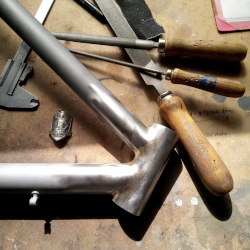If you're in the market for a new steel bike frame, you may be wondering about the differences between tig and fillet brazed welding techniques. In this article, we'll explore the pros and cons of each method to help you make an informed decision.
What is Tig Welding?
Tig welding is a process that fuses metals together by melting them at high temperatures above 1450°C. While this method is relatively easy and clean, it can weaken the metal and result in possible breaks, especially with very thin tubes.
What is Fillet Brazing?
Fillet brazing, on the other hand, "glues" metals together using a lower alloyed metal alloy. This method does not melt the metals to be joined, and as such, does not alter the balance of the tubes. However, it can be a slower and more expensive process.
Fillet Brazed Frame Types
Fillet brazed frames can be divided into two types: those with conjunctions and those without. Frames with conjunctions have a retro charm and are characterized by machined and chrome-plated joints, while frames without conjunctions are stiffer and can be designed with more freedom in terms of geometry.
Pros and Cons
Tig Welding
Pros: Ease of processing, cleanliness, lightness, freedom of geometry.
Cons: Possible breaks with very thin tubes.
Fillet Brazed Frame, Without Conjunctions
Pros: Stiffer than tig, it does not alter the balance of the tubes, pleasant to look at (looks like a monocoque), freedom of geometries like the tig.
Cons: Slow processing, more expensive, a few dozen grams heavier.
Fillet Brazed Frame, With Conjunctions
Pros: Undisputed retro charm with machined and chrome-plated joints.
Cons: Slow processing, more expensive, bound in the choice of angles.
After this quick list of differences, let me explain better what I meant:
Tig vs. Fillet Silver Brazed: Differences between Tig and Fillet Brazed
I will try to clarify this subject often underestimated and misunderstood: what is the difference between a racing bike frame or an MTB steel welded tig and the same welded in fillet brazed?
Without diving into overly technical explanations, I'll try to explain simply. The difference is enormous: tig welding fuses the metals, while fillet brazing "glues" them with a lower alloyed metal alloy.
The latter is divided into two types: frames with conjunctions and frames without. Frames without conjunctions are stiffer and maintain tube balance, resembling a monocoque, while frames with conjunctions have a retro charm with machined and chrome-plated joints.
Regarding the best method among the three, let's analyze and draw conclusions. Today, new steel alloys have exceptional breaking loads, allowing tubes with very thin thicknesses. Tig welding, however, brings the temperature above 1450°C, potentially weakening the metal and causing breaks, especially after the weld bead. In contrast, fillet brazing does not alter the metal's balance significantly, depending on the type of alloy used to join the tubes.
Finally, let's summarize the pros and cons:
Frame in Tig
Pros: Ease of processing, cleanliness, lightness, freedom of geometry.
Cons: Possible breaks with very thin tubes.
Frame in Fillet Brazed, Without Conjunctions
Pros: Stiffer than tig, does not alter tube balance, pleasant appearance, freedom of geometries.
Cons: Slow processing, more expensive, slightly heavier.
Frame in Fillet Brazed, With Conjunctions
Pros: Undisputed retro charm with machined and chrome-plated joints.
Cons: Slow processing, more expensive, limited in choice of angles.
You may also be interested in Which is the typical steel frame weight for a bicycle?








 Every frame I craft is tailored to your unique needs and preferences, ensuring a perfect fit and unmatched performance
Every frame I craft is tailored to your unique needs and preferences, ensuring a perfect fit and unmatched performance